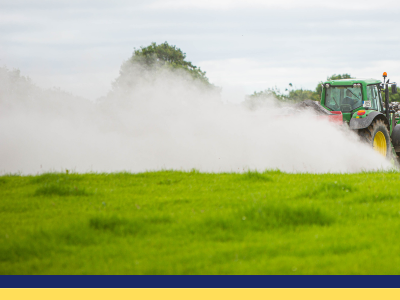Our Hi-Calcium Agri Lime comes from a high purity calcium quarry in Kilkenny and is ground in a modern limestone powders plant on site.
High Calcium Content
Bennettsbridge Limestone is a high calcium limestone quarry, allowing us to produce agri lime with a 98% Calcium Carbonate content. This high calcium content is essential to restore the soils lime status back to the desired pH for optimum fertility and ensure improved soil structure and drainage.
Lime Effectiveness
The effectiveness of agri lime relies on two criteria; how effective it is at neutralising the acidity in the soil and how finely ground it is.
Why Apply Agri Lime?
Increased Grass/Crop Production
Increased grass and grain yields of at least 1.5 t/ha are common when optimum soil pH is achieved. This represents a 7:1 return on investment; €7 in additional grass yield for each €1 invested in lime.
Nutrient Availability
Applying agri lime regularly releases up to 80kgs of N/ha/Year and unlocks phosphorus (P) and potassium (K) from organic soil reserves, reducing the need for applied fertilisers.
Soil Biological Activity
Earthworms and other soil organisms are sensitive to soil acidity. Maintaining a neutral soil pH allows them to thrive and breakdown plant residues, animal manures and release nutrients.
Soil Structure & Drainage
Applying calcium agri lime regularly will help condition the soil, which in turn, will improve soil structure and drainage and allow for better root development and nutrient uptake.
WHAT OUR CUSTOMERS HAVE TO SAY…
“As a result of using lime, we were also getting better graze outs. Our grazing season has also been extended due to a better soil structure. We reseeded 20 acres this year and lime is a key part of ensuring the establishment of a new pasture.”
Mikey Butler, Co. Kilkenny


Bennettsbridge Limestone is as a member of Grolime, Ireland’s only agricultural lime quality assurance scheme. Grolime are committed to promoting the many benefits of ground limestone and continue to work with the Department of Agriculture Food and the Marine and Teagasc as part of its ongoing efforts to increase the knowledge of the benefits of agri lime in Ireland.
LIME – YOUR QUESTIONS ANSWERED
- On silage ground, it is better to lime immediately after cutting, when cover is low. This avoids uptake of lime which can increase the pH in the silage pit, thereby affecting silage preservation. Apply slurry and UREA c. one week before applying lime on silage ground.
- Liming at reseeding is essential to counteract the acid that is produced as the old sward decays.
- Applied lime can increase the loss of N to the air after slurry application.
- Allow slurry to wash into soil (7-10 days) and then apply lime.
- Wait 3 months after liming to spread slurry.
- Summer slurry offers less N than spring slurry, so you may choose to reduce the 3-month rule if the benefits of lime outweighs the slurry N contribution.
- In line with the most recent review of the nitrates derogation, from 2020, a liming programme must be implemented based on your current Nutrient Management Plan (NMP) and associated soil analysis results. This is to ensure an improvement in nutrient use efficiency with a resulting reduction in greenhouse gas (GHG) emissions.
- Lime must be applied based on soil test results and invoices will be required if inspected.
- Farms that must soil sample for derogation 2021 will need to leave 6 months between liming and sampling.
- High levels of Mo in grass can reduce copper uptake in grazing animals. On soils with high Mo status there is an increased risk of copper deficiency occurring.
- Increased soil pH (especially > 6.2) increases Mo availability.
- Minimise soil Mo by maintaining soil pH at a slightly lower range of 6.0 – 6.2.
- Lime can be applied at any time of the year, provided the grass sward is low to avoid excess lime sticking to herbage.
- Lime paddocks when they are grazed out and when rain is forecast. Once lime is washed off the leaf by rain, you can allow livestock back in to graze paddocks.
- Plan to have paddocks that require lime grazed out when silage is being cut, giving large areas of bare cover available for lime where required.
- Typical lime requirements is 2.5 to 5.0 tonnes per ha, every 3-5 years. Soil test regularly to confirm lime requirements. Apply a maximum of 7.5t/ha (3.0t/ac) in a single application. Where more lime is recommended, apply the balance after two years.
- Lime can be applied at any time of the year, provided the grass sward is low to avoid excess lime sticking to herbage. Mid-summer and autumn are ideal as soils are dryer and firm and there are increased spreading opportunities after grazing and post silage.
- Both Calcium Lime and Magnesium Lime are excellent at correcting soil acidity.
- It is the Calcium element of Calcium Carbonate Lime that improves soil structure and drainage.
- The Magnesium in Magnesium Carbonate Lime does not have the same positive effect on soil structure.
- Granulated Lime is fine limestone powder reformed into a granule, that is available to the soil immediately. It very convenient because it can be spread using a conventional fertilizer spreader.
- Teagasc continue to recommend normal ground limestone lime from quarries as it is much better value for money.
Related News
Take a look at the latest news from Bennettsbridge Limestone
Mikey Butler on striking the right balance in different fields
Mikey Butler is among an increasingly rare breed of full-time farmers now operating at the highest level of inter-county hurling. The 2022 Young Hurler of the Year, who was also [...]
National Liming Programme- What you need to know
With the new National Liming Programme subsidy announced, and the closing date of April 20th just around the corner, lets look at the details involved. Q- What is the [...]
September – The best time to plan lime and fertiliser applications
With increased fertiliser prices set to remain for the coming season, it is critical that the correct steps are taken this autumn to maintain soil fertility. September is the ideal [...]



